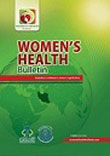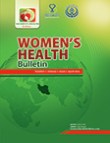فهرست مطالب

Women’s Health Bulletin
Volume:3 Issue: 3, Jul 2016
- تاریخ انتشار: 1395/04/26
- تعداد عناوین: 7
-
-
Life Satisfaction and its Determinants Among Young Iranian WomenPage 1BackgroundSatisfaction with life indicates an individuals overall evaluation of life, which is influenced by a range of factors including socio-demographic characteristics, psychological issues, and life experiences..ObjectivesThe aim of this study was to explore the main determinants of life satisfaction among young Iranian women..
Patients andMethods391 young Iranian women (18 - 35 years) were recruited through cluster convenience sampling to participate in this cross-sectional study. Satisfaction with life (SwL) was used as the dependent variable. Demographic characteristics together with the individual items of the Persian version of the WHO QoL-BREF (World Health Organization quality of life questionnaire-brief version) were used as the independent variables and/or the determinants of SwL..ResultsThe analysis showed that young Iranian womens satisfaction with life was average (19.9 ± 6.4), ranging from 5 to 35. The regression analysis identified higher income, better living conditions, higher level of leisure activities, and satisfactory sexual life as the main predictors of higher satisfaction with life. Satisfaction with life diminishes with increased age, being divorced and/or widowed and being of Lor ethnicity (vs. Fars and Tork ethnicities). On the other hand, those with higher education and/or level of religiosity had a higher satisfaction with life..ConclusionsIn transitional countries, particularly those with different social and cultural situations, identifying and enhancing the main determinants of SwL is of importance in order to improve socially cohesive and robust community..Keywords: Satisfaction With Life, Quality of Life, Demographic Characteristics, Young Women, Iran -
Page 2BackgroundBody image is an important factor in womens lives..ObjectivesThe purpose of the current study was to explore the association among body image, perceived physical fitness and its subscales, physical activity, body mass index and age in women..
Patients andMethodsThis cross-sectional study was carried out on a sample of 82 women from University of Tabriz staff and masters. Participants were selected through convenience sampling. Individual characteristics, physical activity rate, body image and perceived physical fitness questionnaires were completed. Data were analyzed by Kolmogorov-Smirnov, Pearsons correlation coefficient and regression..ResultsThe results of the study indicated a significant linear association of body image with body mass index (r = 0.769, P = 0.0001), body composition (r = 0.587, P = 0.0001), and aerobic endurance (r = - 0.229, P = 0.038). In addition, there was no significant linear relationship between physical activity and other variables, except for flexibility (r = 0.258, P = 0.019) and age (r = 0.418, P = 0.0001). Regression analysis showed that physical self-perception, aerobic endurance, body composition, muscular strength, flexibility, and body mass index could predict 64% of the variance of body image..ConclusionsPhysical self-perception and its factors along with body mass index are important to build up body image. Some interpretations and limitations about physical activity motives and measurements were also cited..Keywords: Body Image, Self, Concept, Motor Activity, Body Mass Index, Women -
Page 3BackgroundA healthy lifestyle plays an important role in promoting good health and preventing deseases..ObjectivesThis study aimed to investigate the promotion of healthy lifestyles for women in Kerman, Iran..Materials And MethodsA cross-sectional study was conducted on 400 women admitted to urban health centers in Kerman during 2014. Data was collected using a questionnaire containing demographic data and a health-promoting lifestyle profile. Scores ranged between 0 and 100. Higher scores indicated healthier lifestyles. The data was analyzed using SPSS software..ResultsThe mean age of the participants was 33.94 years. Most were married, unemployed, and had a high school diploma. The mean score for health-promoting lifestyles was 50.62 ± 14.16. Nutrition and physical activity had the highest and lowest scores, respectively. Married women had higher scores in health responsibility and nutrition..ConclusionsData from our study revealed the necessity for women to pay more attention to planning healthy lifestyles, especially in terms of physical activity. Since women play a crucial role in shaping their childrens habits, more educational intervention is needed to improve healthy lifestyle habits..Keywords: Health Promotion, Lifestyle, Women, Kerman
-
Page 4BackgroundObesity is an identity that is the result of the overweight persons experience and perception of this problem..ObjectivesThe purpose of this study is to evaluate various aspects of the lived experience and changes in the self for 29 sleeve surgery patients from two hospitals in southern Iran..
Patients andMethodsAfter in-depth, open-ended interviews with 29 sleeve candidate patients (24 females and 5 males), their statements were analyzed through a thematic method..ResultsFindings revealed that obesity is a continually negative experience with four characteristics for participants: losses, limitations, psychological pressures, and social pressures. These experiences can lead to profound changes in the self and cause the patient to develop self-hatred, submissiveness, and passivity..ConclusionsObesity involves a diversity of negative experiences; more consideration should be given to overweight people, especially overweight women. Accordingly, social policymakers should help by desensitizing this problem in society through media, universities, and schools. Also, fostering a positive attitude in these individuals is important and would require paying attention to their individual, psychological, and social needs through teamwork..Keywords: Obesity, Experiences, Self, Psychological, Social Problems -
Page 5BackgroundThere is biologic and clinical evidence that links vitamin D deficiency to pre-eclampsia. The Vitamin D receptor is present in the placenta, cardiovascular system, and lymphocytes. It has anti-inflammatory, immune regulatory, and anti-hypertensive properties and facilitates placental implantation. Each of these processes is involved in the pathogenesis of pre-eclampsia..ObjectivesThe main purpose of this study was to study the relationship between vitamin D deficiency and severe pre-eclampsia in a population residing in southern Iran that is generally known to have a high prevalence of vitamin deficiency. As a second objective, the prevalence of vitamin D deficiency in pregnant women was investigated..
Patients andMethodsWe conducted a case-control study of 59 patients with severe preeclampsia and 217 controls, all of whom were from southern Iran. Cases and controls were matched for age, body mass index, and gestational age. The study was carried out in autumn and winter. Plasma 25-hydroxyvitamin D was measured using high performance liquid chromatography, and the results were compared between the two groups..ResultsAlmost all controls and patients had 25-hydroxyvitamin D levels below normal, and 69% had levels below 10 ng/mL. The mean 25-hydroxyvitamin D levels in the patient and control groups were 8.4 (6.2) and 8.5 (6.9) ng/ml (P = 0.80), respectively. The level of 25-hydroxyvitamin D had no significant association with subjects body mass index or age..ConclusionsPregnant women in our region have a high prevalence of vitamin D deficiency, and in a population with severe vitamin D deficiency, there is no significant correlation between 25-hydroxyvitamin D levels and preeclampsia. Severe deficiency masks any possible association in a case-control study. Controlled trials with vitamin D supplementation are recommended for further studies..Keywords: 25, Hydroxyvitamin D, Preeclampsia, Vitamin D, Iran -
Page 7Context: Articles discussing human milk banking and the sharing of milk among women have increasingly been appearing in the medical and nursing literature in the early-21st century. The articles usually focus on Western-style milk banks, as well as informal ways of providing womens milk to premature or sick infants and others in need of human milk. This article will review this literature within the context of Muslims living in predominantly Islamic countries and the potential effects of migration within a country or to another country on knowledge of these issues..
Evidence Acquisition: Articles consulted were sourced from the bibliographies of the authors previous articles and the references in other articles consulted during previous research. Following that, a search of the term milk kinship was conducted on Medline via Web of Science and in PubMed, but all relevant articles had already been accessed..ResultsA relatively few articles have discussed these matters in the Islamic context, to acknowledge the constraints that the creation of a kinship relationship by milk under Islamic law places on how breastfeeding or breast milk is shared. Nevertheless, these issues, and how needy infants can be provided with the life-giving breast milk they need, have begun to receive attention in international journals. Yet Muslim mothers may not be conversant with the issue of milk kinship in relation to milk banking or milk donation..ConclusionsSome recent authors have made recommendations on how human milk donation can be achieved in the hospital setting through complying with the religious requirements. Donated human milk can be used in the hospital, provided the conditions are met..Keywords: Breast Feeding, Milk, Human, Milk Banks, Islam


